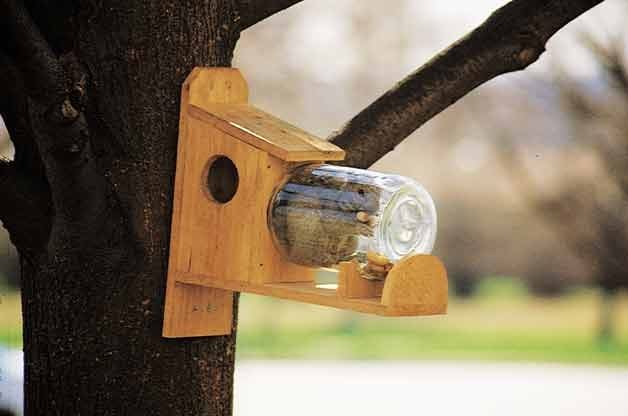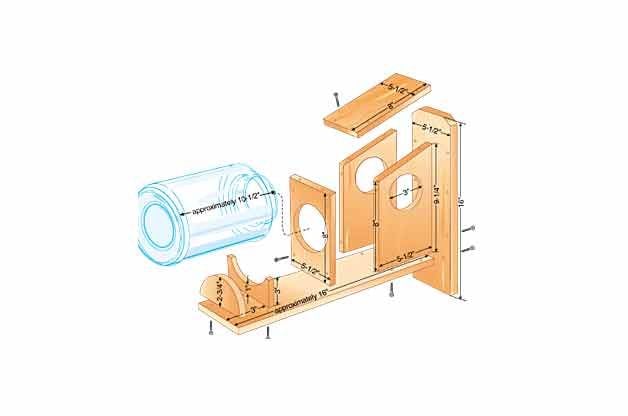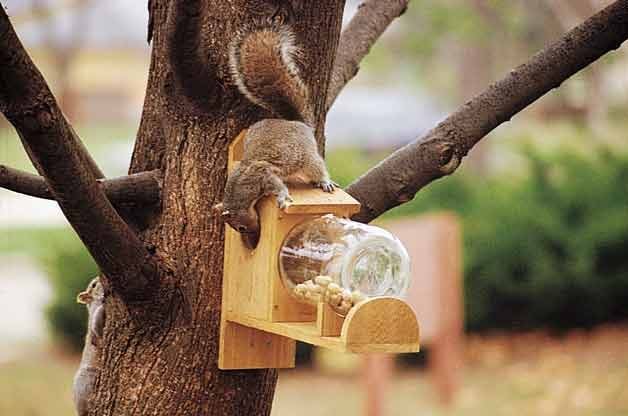How to Make a DIY Squirrel Feeder
Updated: Nov. 15, 2023

Most people enjoy the antics of squirrels in their backyard. This DIY Squirrel Feeder provides an unusually clear view of the squirrels that frequent it!
Many backyard birders also enjoy watching squirrels. That’s why we think you’ll like this “squirrel under glass” feeder. The DIY squirrel feeder offers a clear view of the squirrels, because the crafty critters actually climb inside the feed jar to eat!
James Motsinger of Manor, Texas shares the fun design. His “squirrel under glass” feeder provides a whole lot of entertainment in his backyard. As a side benefit, it helps keep the squirrels from raiding the bird feeders in his yard. Just mount it on the opposite end of your yard away from bird feeders and keep it filled.
James designed the squirrel feeder with holes in the sides large enough for the furry critters to crawl through, but snug enough to make the structure feel like a nesting box.
While squirrels were his target audience, the feeder has attracted a few other interesting visitors, too.
“I’ve found birds feeding in it, particularly during bad weather,” James says. “They seem to like being able to feed where it’s dry.”
Another plus is that this feeder requires only a minimum of materials. All that’s needed is a 6-foot fence board, a handful of screws and a 1-gallon glass jar. If you don’t have the glass jar, or don’t want to eat a year’s supply of pickles to build this feeder, ask local restaurants, schools or other establishments that buy food in bulk if they have a jar to spare.
“Offer to trade a finished feeder for a supply of jars,” James suggests. “If you can’t find a free jar, a sun tea jar bought at the store will work, too.” Just be sure it has an inside diameter of at least 6 inches, so squirrels can dine in comfort.
DIY Squirrel Feeder Materials:
- One 6-foot 1-inch × 6-inch “dog-eared” cedar fence board
- 2-1/2-inch and 1-5/8-inch galvanized deck screws
- One 1-gallon glass jar
Tools:
- Saber saw
- Rasp or rough sandpaper
- Compass
Step-By-Step Instructions:
Step 1
Cut the pieces from a 6-foot 1-inch × 6-inch fence board according to the board layout at left.
Step 2
Make the jar support by tracing the curve of the jar onto the wood. The lowest point of the curve should be 1 inch from the bottom of the board.
Cut along the line with a saber saw. Place the jar on the support to check that it fits well. Trim the sharp corners off the support (about 1/4 to 1/2 inch) and smooth rough edges with sandpaper.
The curved piece remaining from this will become the end piece.
Step 3
Cut entrance holes in both side pieces. Mark a spot about 3-1/2 inches from the highest corner of each board and center the hole from side to side. Draw a 3-inch-diameter circle with a compass, then cut out the holes with a saber saw. Smooth rough edges with sandpaper.
Step 4
Make a hole in the front of the feeder to hold the neck of the jar. This is a tricky step because jars vary in size. Start by determining the radius of the jar’s mouth. Then lay the jar on its side and measure from the tabletop to the bottom of the mouth. Add these two measurements plus 1 inch. Mark this distance from the bottom of the front board and center.
From this point, draw a circle 1/2 inch larger than the diameter of the mouth. Cut the hole with a saber saw.
Step 5
Assemble the front and sides of the squirrel feeder, then attach the assembled pieces to the base. These joints, and all others, will be fastened with 1-5/8-inch galvanized deck screws. Cedar splits easily, so be sure to drill pilot holes in each piece before driving in the screws.
Step 6
Attach the jar support about 3 inches from the far end of the base. Then position the rounded end piece—which keeps the jar from sliding out of the feeder—at the edge of the base. However, make sure there is enough clearance for you to tip the jar out for filling. If it’s too tight, use a rasp to round the inside curved edge of this end piece until the jar can easily be removed. If the jar is too loose, move the rounded end farther up the base before attaching it.
Step 7
Predrill holes in the mounting board, then attach it to the feeder with 1-5/8-inch deck screws.
Step 8
If you’d like to make a beveled edge on the roof piece so it tightly meets the mounting board, cut a 15° angle on the back edge with a table saw. Then attach the roof to the sides of the feeder, again using 1-5/8-inch deck screws.

Step 9
Mount the feeder on a tree with 2-1/2-inch deck screws (this is a heavy feeder—you’ll need large screws to mount it securely) and fill it with peanuts in the shell, cracked corn or birdseed. Then check your watch. It won’t be long before you’ll be inviting the neighbors over to admire your “squirrel under glass”!

